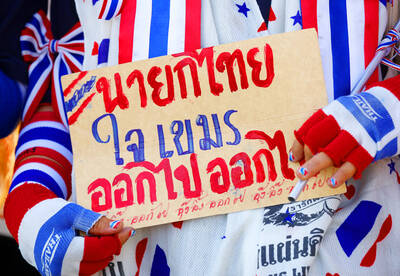Followers of Mexico’s “Saint Death” cult figure, revered by thieves and drug runners but also law-abiding housewives, say their faith is being persecuted by the government’s war against drug cartels.
Dozens of worshipers marched through Mexico City on Good Friday, many barefoot and showing off tattoos of the macabre cult figure, in the latest of a series of protests after soldiers and police bulldozed elaborate roadside shrines to the saint near the northern border with Texas.
Known as “Santa Muerte” in Spanish, the saint is often depicted as a skeletal “grim reaper” draped in white satin robes, beaded necklaces and carrying a scythe. Followers leave offerings of tequila, rum, beer, cigarettes, cash, flowers and candy at altars adorned with rosaries and candles.
Mexican authorities destroyed more than 30 such shrines erected near the city of Nuevo Laredo last month on the grounds that they were built without the proper licenses. Some shrines were also knocked down in Tijuana, triggering protests there.
“We just want people to respect our faith like we respect other religions,” said Pablo, a 28-year-old at the protest who said he once avoided a jail sentence by praying to Saint Death.
The Catholic Church frowns on the cult, whose origins may trace back to Aztec and Mayan death-gods or to ancient European traditions, but many devotees call themselves Catholics.
The lure of the death saint is that she is said to honor requests without judging them.
Her followers number up to 5 million, said the cult’s high priest David Romo, ranging from police and politicians to kidnappers and gangsters who are said to ask her for protection before setting out on hits.
Romo said his church condemned violence and had no links to drug traffickers, but he leaves the door open to everyone.
“Christ went to see prostitutes, thieves, all marginalized people,” Romo said in his cramped office in the saint’s largest sanctuary in Mexico City, a run-down storefront around the corner from a street lined with prostitutes.
Mexican President Felipe Calderon has launched an army assault on Mexico’s drug gangs, but the increased firepower has failed to contain the violence. Some 6,300 people were killed last year.
In 2007, gunmen from the powerful Gulf Cartel handcuffed three men and shot them dead at a Santa Muerte altar in Nuevo Laredo, leaving lit candles, flowers and a taunting message for rivals.
At the shrine in Tepito — a rough part of the capital with a market that reputedly sells contraband and drugs — chicken coops line the walls near the pews facing two life-sized skeleton statues wearing glittering dresses and crowns.
Friday’s marchers walked in silence from the shrine to Mexico City’s historic center, carrying Saint Death statues and flaming torches. One held a skull on a stick sporting wispy black hair.

Eleven people, including a former minister, were arrested in Serbia on Friday over a train station disaster in which 16 people died. The concrete canopy of the newly renovated station in the northern city of Novi Sad collapsed on Nov. 1, 2024 in a disaster widely blamed on corruption and poor oversight. It sparked a wave of student-led protests and led to the resignation of then-Serbian prime minister Milos Vucevic and the fall of his government. The public prosecutor’s office in Novi Sad opened an investigation into the accident and deaths. In February, the public prosecutor’s office for organized crime opened another probe into

RISING RACISM: A Japanese group called on China to assure safety in the country, while the Chinese embassy in Tokyo urged action against a ‘surge in xenophobia’ A Japanese woman living in China was attacked and injured by a man in a subway station in Suzhou, China, Japanese media said, hours after two Chinese men were seriously injured in violence in Tokyo. The attacks on Thursday raised concern about xenophobic sentiment in China and Japan that have been blamed for assaults in both countries. It was the third attack involving Japanese living in China since last year. In the two previous cases in China, Chinese authorities have insisted they were isolated incidents. Japanese broadcaster NHK did not identify the woman injured in Suzhou by name, but, citing the Japanese

YELLOW SHIRTS: Many protesters were associated with pro-royalist groups that had previously supported the ouster of Paetongtarn’s father, Thaksin, in 2006 Protesters rallied on Saturday in the Thai capital to demand the resignation of court-suspended Thai Prime Minister Paetongtarn Shinawatra and in support of the armed forces following a violent border dispute with Cambodia that killed more than three dozen people and displaced more than 260,000. Gathered at Bangkok’s Victory Monument despite soaring temperatures, many sang patriotic songs and listened to speeches denouncing Paetongtarn and her father, former Thai prime minister Thaksin Shinawatra, and voiced their backing of the country’s army, which has always retained substantial power in the Southeast Asian country. Police said there were about 2,000 protesters by mid-afternoon, although

MOGAMI-CLASS FRIGATES: The deal is a ‘big step toward elevating national security cooperation with Australia, which is our special strategic partner,’ a Japanese official said Australia is to upgrade its navy with 11 Mogami-class frigates built by Japan’s Mitsubishi Heavy Industries, Australian Minister for Defence Richard Marles said yesterday. Billed as Japan’s biggest defense export deal since World War II, Australia is to pay US$6 billion over the next 10 years to acquire the fleet of stealth frigates. Australia is in the midst of a major military restructure, bolstering its navy with long-range firepower in an effort to deter China. It is striving to expand its fleet of major warships from 11 to 26 over the next decade. “This is clearly the biggest defense-industry agreement that has ever